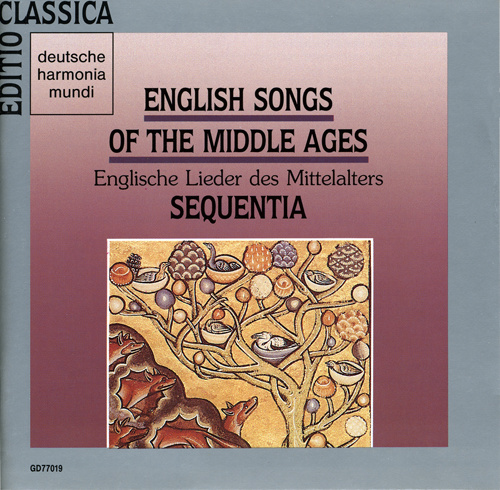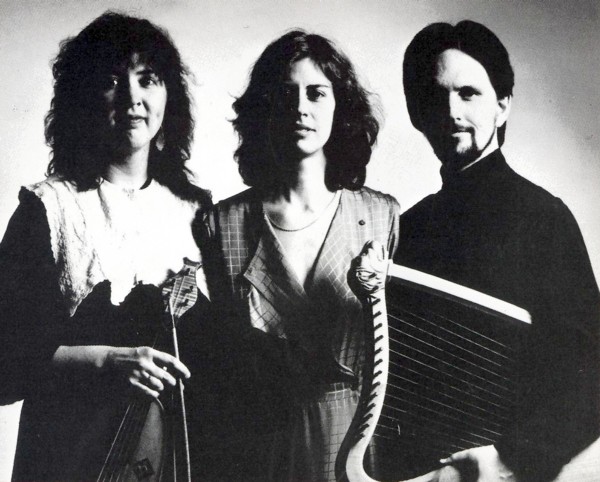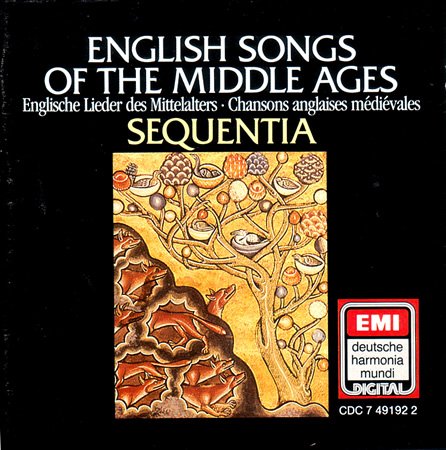English Songs of the Middle Ages / Sequentia
Englische Lieder des Mittelalters

medieval.org
sequentia.org
Deutsche Harmonia Mundi 77019
1987
St. GODRIC · ±1170
1. Sainte Marië viërgenë – Crist & St.
Marië – St. Nicholas [4:12]
ensemble
2. The milde Lomb, isprad o rode [10:17]
The gentle Lamb — B. Thornton · Fidel
3. Edi be thu, heven-queenë [2:22]
instrumental — Fidel · Harfe · Symphonia
4. Ar ne kuth ich sorghe non [4:49]
Formerly I knew no sorrow — B. Bagby · Fidel
5. Dance / Tanzstück / Danse [2:08]
Fidel
6. Jesu Cristes mildë moder [6:09]
Jesus Christ's gentle mother — B. Bagby · E. Brownless
7. Worldes blis ne last no throwë [11:29]
Worldly bliss — B. Thornton · Harfe
8. Instrumental [1:39]
Fidel
9. Fuwëles in the frith [0:46]
Birds in the woodland — B. Thornton · B. Bagby
10. Man mai longë lives weenë [6:56]
Man may expect long life — B. Thornton · Symphonia
11. Byrd onë brerë [2:15]
Bird on a briar — B. Thornton
12. Edi be thu · heven-queenë [2:35]
Blessed be thou · queen of heaven — B. Thornton · E.
Brownless
13. Ar ne kuth ich sorghe non [4:08]
instrumental Lai — Fidel · Harfe

SEQUENTIA
Ensemble für Musik des Mittelalters
Barbara Thornton · Gesang
Benjamin Bagby, Gesang, Harfe, Symphonia
Margriet Tindemans, Fidel
mit:
Edmund Brownless, Gesang
Instrumente
Zwei 5saitige Fideln von Fabrizio (Fonte Alto, Italy) 1978.
14saitige Harfe von Geoff Ralph (London)1981.
21saitige Harfe von Rainer Thurau ((Ulm) 1985.
Symphonia von Bernhard Ellis (Dilwyn, Herefordshire) 1978.
© 1988 by harmonia mundi, D-7800 Freiburg
Ⓟ 1989 by harmonia mundi, D-7800 Freiburg
Produzent: Klaus L. Neumann
Aufgenommen: 23.-25.V1.1987, Cedernsaal Schloß Kirchheim
Dr. Thomas Gallia · Paul Deny (Sonart, Milano)
Kommentar: Benjamin Bagby, Margriet Tindemans
Titelseite:
Motiv: lat. 8846, f 3v. Bibliothèque Nationale, Paris
Gestaltung Vorderseite: B &M Wiesinger
Redaktion: Dr. Jens Markowsky, Rudolf Moratscheck
All rights reserved
HARMONIA MUNDI D-7800 FREIBURG
Eine Co-Produktion mit dem WDR, Westdeutscher Rundfunk Köln

“Worldes blis” — English songs of the Middle Ages
The repertoire of songs in English from the 12th to the early 14th
centuries is surprisingly small. We know that much music composed to
English texts is lost to us (due to the oral mode of vernacular song
transmission), and must therefore content ourselves with the less than
two dozen pieces, some in fragmentary form, which have survived in a
variety of manuscript sources, including a saint's life, a book of
miscellaneous religious writings, and even the reverse side of a papal
bull. Unfortunately, there exist no large manuscript collections of
English song comparable to the chansonniers of the Troubadours and
Trouvères, since the courtly, literate, — and therefore
written — tradition in England before Chaucer's time was largely
French. Anglo-Norman song was the fashion amongst the aristocracy, and
those pieces with English texts which found their way into writing came
for the most part from a religious-scholastic milieu, such as the
Franciscans, in which English was prevalent.
In bringing these songs back to life, our point of departure has always
been to concentrate on the texts, as they are found in the original
musical sources as well as in published editions. Such comparative work
helps the singer to establish a working text, and can often shed light
on problems of meaning and emphasis, orthography and pronunciation.
Having a satisfactory basic text for a poem begins a long process of
interiorizing every aspect of the poet's art, from the acoustical
properties of the language (vowel and consonant sounds, rhyme, inner
rhyme, alliteration, etc.) to comprehending the sense of specific word
choices and rhetorical devices.
As this process continues, the singer realizes that a given edition is
often at odds with the text as found in the musical source, which can
be unclear or even garbled. Since our principle has been to depart from
the musical source as little as possible, we have chosen the manuscript
version when a text editor has made changes which would necessitate
modification of the musical setting. Sometimes the musical information
provided by the manuscripts is also ambiguous, or we have reason to
suspect scribal error. For instance, the final line of “Bryd one
brere” may be sung a third lower if one agrees that the scribe
made a mistake in placing a c-clef (we have chosen to record the
version as found in the manuscript).
In general, we have assumed that a written musical source is not an
Urtext of a song, but rather a written documentation — however
incomplete — of some stage in the song's active life. A
manuscript may represent a remembered performance, dictated or
otherwise transmitted to a scribe, or it might have a more direct
connection with the singer himself, or a musician from the original
singer's tradition.
The subject of rhythm in medieval song has generated much partisan
discussion. Given that the notation of these pieces is often
rhythmically ambiguous and open to various interpretations, we have
tried to avoid a dogmatic approach in favour of an evaluation of each
individual song. For example, “Edi be thu, heven-queene”
lends itself naturally to a simple rhythmic pattern based upon the
text, whereas “The milde Lomb” or “Worldes
blis” demonstrate a more subtle use of melody, and a style which
is essentially ornamental and impossible to fix in rhythmic units. In
another case, the sequence “Jesu Cristes milde moder”, we
have chosen a type of musical recitation which avoids rhythmic
regularity and follows the shifting patterns in the text. The
performance of “Bryd one brere” recorded here reflects the
inconsistent use of mensural notation found in the source, and hence,
re-creates a performance containing passages which the scribe would
have found difficult to notate using the symbols available to him.
Decisions about the use (or non-use) of instrumental accompaniment were
also made according to the character and structure of each song. An
accompaniment may consist of a simple drone, or it may employ the more
complex techniques of heterophony, mirroring and commentary, but in all
cases the melodic vocabulary of the instrumental part is derived from
the songs themselves or other pieces from English sources of the
period. For St. Godric's song in praise of St. Nicholas, the simple
melody has been amplified through techniques of polyphonic vocal
elaboration which would have been part of an oral tradition in medieval
clerical circles.
Benjamin Bagby

Notes on instrumental music
The definition of an “instrumental” style is a long process
and is possible only through a close study of the vocal repertoire. The
existing instrumental pieces, like the estampie in the Oxford MS
(Bodleian Library, MS Douce 139, f.5) give us some information about
forms and melodic structure, but they are very few and diverse, and do
not permit us to rebuild a tradition of instrumental playing using only
those sources.
From literary sources we know that vocal music was played on
instruments, but we have little information about how the material was
used in an instrumental performance. Given the specific possibilities
of each instrument and the fact that a large part of the instrumental
music served as dance music, it seems likely that the medieval
instrumentalist would re-arrange the material freely and add to known
melodies.
For the pieces on this record we have made use of simple dance forms,
such as the rondeau (“Edi be thu, heven-queene”, Nr. 3)
estampie (Oxford MS, Nr. 5 on this record), and the more complex lai
(“Ar
ne kuth ich sorghe non”, Nr. 13 on this record). The instrumental
arrangements were made by Margriet Tindemans, using melodic material
from the vocal pieces whose titles they bear. Sometimes melodies from
related songs were added; at other times we made and improvised new
melodies while staying as close as possible to the original material.
Margriet Tindemans





